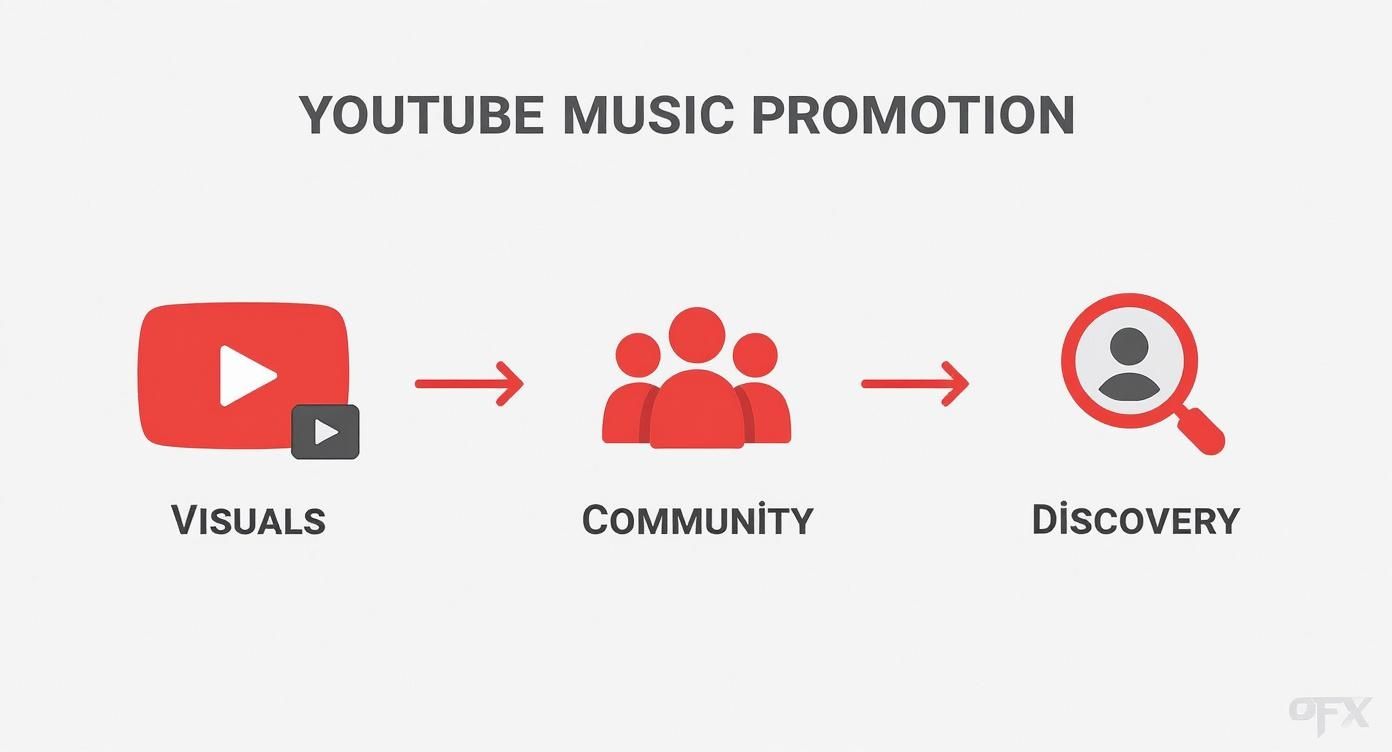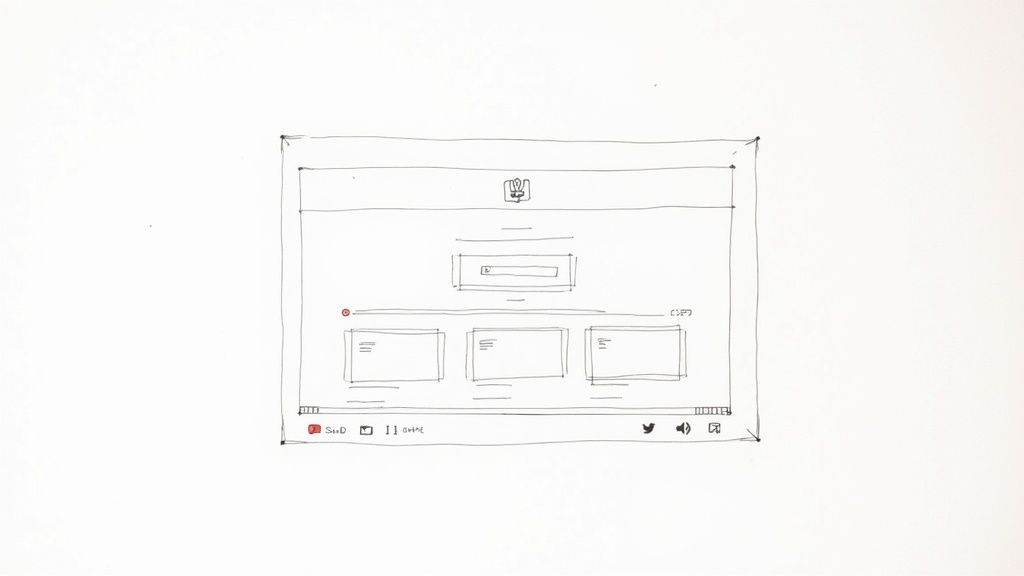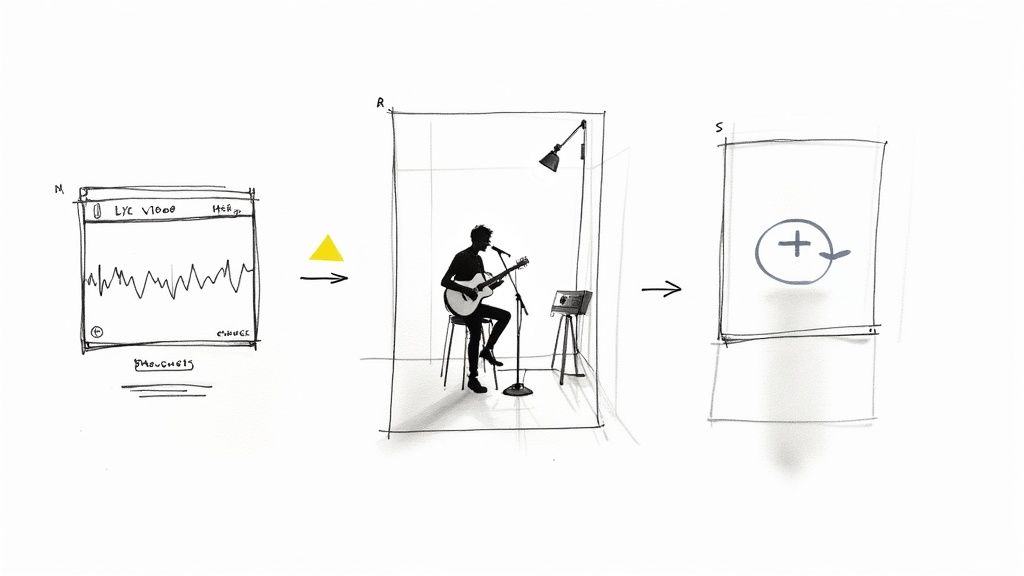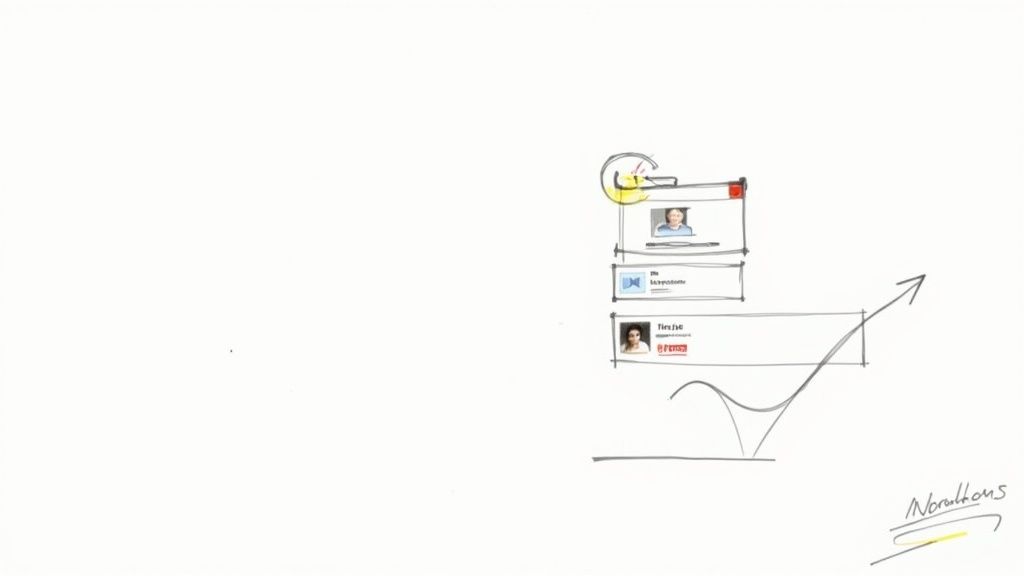How to promote your music on youtube: Quick, proven tactics
- CHRXS JVMMY
- 14 hours ago
- 14 min read
Promoting your music on YouTube is way more than just uploading a music video and hoping for the best. It's really a blend of channel optimization, creating killer video content, and getting smart with SEO.
The goal here is to turn the platform into a powerful engine for discovery and connecting with fans. You're using its unique community features and visual storytelling tools to build a real, dedicated audience.
Why YouTube Is Your Ultimate Stage
First, stop thinking of YouTube as just a video hosting site. It's a living, breathing ecosystem where artists are building sustainable careers.
It combines visual storytelling with powerful community tools, creating the perfect stage for musicians to connect with fans on a much deeper level. This isn't just about racking up views; it's about crafting an entire visual world around your sound.
In 2025, YouTube is still one of the biggest platforms for music promotion, with over 2.7 billion monthly active users around the globe. That massive reach lets artists engage audiences with music videos, lyric videos, and especially short-form content like YouTube Shorts, which have absolutely blown up.
This infographic breaks down the core process of promoting your music on YouTube, from the visuals all the way to discovery.

As you can see, successful promotion is a cycle. Great visuals fuel community engagement, and that engagement boosts your discovery through the algorithm.
To really nail your YouTube strategy, it helps to break it down into a few core pillars. Focusing on these areas will create a feedback loop that drives growth and turns casual listeners into die-hard fans.
Pillar | Primary Goal | Key Action |
|---|---|---|
Visual Identity | Build a memorable brand | Maintain a consistent aesthetic in channel art, thumbnails, and video styles. |
Community Engagement | Turn viewers into fans | Actively reply to comments, host live Q&As, and create interactive content. |
Algorithmic Discovery | Reach new audiences | Optimize video titles, descriptions, and tags with relevant keywords. |
Each of these pillars supports the others. A strong visual identity makes your content more clickable, good engagement signals to the algorithm that your content is valuable, and solid SEO puts your videos in front of the right people.
The key is to see YouTube not as a distribution channel, but as a direct-to-fan communication tool. Your channel is your digital venue, your content is the performance, and your subscribers are the front-row audience.
Ultimately, your YouTube efforts should sync up with your broader online presence. For more on this, check out our guide on social media marketing for musicians to see how all these strategies fit together.
Building Your Channel for a Killer First Impression

Think of your YouTube channel as your digital stage. Someone discovers one of your songs, loves it, and clicks through to see what else you've got. What they find in that moment will either turn them into a subscriber or send them clicking away forever.
This is your shot to convert a casual listener into a real fan.
It's a lot like walking into a music venue for the first time. If it's well-designed and professional, you feel invited to stick around and explore. If it's messy and looks amateur, you're probably heading for the door. Your channel’s branding is what creates that inviting atmosphere.
Every single visual element needs to feel cohesive and true to your artistic identity. From your profile picture to your channel banner, the goal is to tell a story about your music before a visitor even has to press play.
Designing Your Digital Storefront
Your channel art and profile picture are the first things anyone sees. They show up everywhere—on your channel page, in search results, and right next to every comment you leave. You have to make them count.
Profile Picture: Go with a high-quality headshot or your artist logo. It has to be something instantly recognizable, even when it's shrunk down to a tiny circle. Keep it clear and impactful.
Channel Banner: This is your billboard. It’s the perfect spot to announce a new album, plug upcoming tour dates, or just establish your brand's vibe. Pro tip: Keep the most important info centered so it doesn't get awkwardly cropped on phones.
According to a study from Deloitte, a staggering 82% of Gen Z finds new artists through social media and videos on platforms like YouTube. A professional-looking channel is your key to building instant credibility with this massive audience.
The About Section Is Your Digital Bio
So many artists just sleep on the "About" section. This is a huge mistake. It's a goldmine for both connecting with fans and boosting your channel's SEO. This is your chance to tell your story, define your sound, and give industry folks a way to get in touch.
Don't just write a boring paragraph. Structure it for impact. Kick it off with a killer one-sentence pitch that perfectly describes your music. Then, follow up with a short bio that touches on your journey and what inspires you.
Even more important, you need to load it up with relevant keywords that describe your genre, your city, and artists you sound like. This is how you tell YouTube's algorithm who you are so it can recommend your channel to the right people. Put yourself in a fan's shoes: what would they type into the search bar to find music like yours?
Your 'About' section isn't just a bio; it's a strategic tool. Pack it with keywords like "indie pop band in Brooklyn" or "lo-fi beats for studying" to attract organic traffic from listeners searching for a specific vibe.
Finally, make sure you add links to your website, Spotify profile, and other social media accounts. You want to create a connected ecosystem where it's easy for fans to find you everywhere.
Organize Your Content with Playlists
An unorganized channel page with a random list of videos is just overwhelming. Playlists are the fix. They act like curated collections that guide viewers through your content, and they're one of the best ways to get people to watch more of your stuff.
Grouping your videos logically just makes for a better experience. Seriously, getting your playlists right is a core part of promoting your music on YouTube because it directly encourages binge-watching.
Try creating playlists for things like:
Official Music Videos
Live Performances & Acoustic Sessions
Behind-the-Scenes & Vlogs
Albums & EPs (in track order)
Once you have them, feature your most important playlists right on your channel’s homepage. That way, new visitors immediately see the depth of your work and can easily dive straight into your catalog.
Creating Video Content That Connects

A killer song deserves more than a single, high-budget music video that you drop and forget. If you're serious about promoting your music on YouTube, you need to think bigger. Your channel should be a living, breathing documentary of your artistic journey, not just a static portfolio of finished tracks.
The real goal here is to build a narrative around your music. When you mix polished official releases with raw, personal content, you forge a much deeper connection. This is how you turn casual listeners into a true community. Plus, it keeps your channel active, constantly feeding the YouTube algorithm fresh content to work with.
Beyond the Official Music Video
Your main music video is a cornerstone, for sure. But it shouldn't be the only pillar holding up your channel. In fact, more budget-friendly and creative content can often pull in way more engagement because it feels authentic and personal. Fans who love your music want to see the person behind the art.
Here are a few powerful and accessible video formats to get you started:
Lyric Videos: These aren't just static text on a screen anymore. With dynamic typography and compelling visuals, you can create something highly shareable that people will watch over and over. They are also fantastic for SEO—all those lyrics in the video and description are gold for search engines.
Acoustic Sessions: Strip your songs down to their core. Film a raw, intimate acoustic performance in a unique spot—your studio, a park, even your living room. It showcases your raw talent and gives fans a totally new perspective on a track they already love.
Behind-the-Scenes Vlogs: Take your audience with you. Show them what it's like in the studio during a recording session or walk them through your songwriting process. This kind of "insider" content makes fans feel personally invested in your journey.
For more strategic insights on making your main video pop, check out our guide on how to promote a music video and maximize its impact.
Harnessing the Power of YouTube Shorts
YouTube Shorts are a non-negotiable tool for music discovery today. Seriously. Their short, vertical format is built for rapid consumption and can get your music in front of thousands of new listeners who might never have found your channel otherwise. They are your secret weapon for algorithmic reach.
Think of YouTube Shorts as your digital street team. Each short is a quick, compelling pitch for your music, sent out to find potential fans where they're already scrolling.
To make Shorts really work for you, you have to grab attention within the first two seconds. The key is variety and consistency. Try to post several Shorts every week, especially when you have a new release coming out.
Effective Ideas for Music Shorts
Tease a Hook: Find the catchiest 8-15 seconds of your new song and pair it with a simple, eye-catching visual loop.
Share Studio Moments: A quick clip of you laying down a guitar track or celebrating a finished mix can be incredibly engaging. It's real.
Answer Fan Questions: Use the "reply with a Short" feature on comments. This is an awesome way to create interactive content that makes your audience feel seen.
Showcase Your Personality: Got a funny tour story or a candid moment? Share it. People connect with people, not just with music.
Mastering YouTube SEO for Music Discovery

Making killer music is one thing; getting people to actually find it is a whole different ball game. YouTube isn't just a video site—it's the second biggest search engine in the world, right behind Google. If you can figure out its algorithm, you can unlock a constant stream of organic discovery.
This is how your music promotes itself, even when you're not actively pushing it.
Think of SEO (Search Engine Optimization) as leaving a trail of breadcrumbs for new listeners. When you nail it, YouTube starts doing the heavy lifting for you, recommending your content to people who are primed to become your next biggest fans.
Researching Keywords Your Fans Use
Before you even think about hitting "upload," you need to climb inside the mind of a potential listener. What are they actually typing into that search bar? Your mission is to find those exact terms and build your video's entire metadata around them.
A great starting point is YouTube's own search bar. Start typing your genre or an artist you sound like and watch what it auto-suggests. These aren't guesses; they're real searches people are making every day. If you make chill electronic stuff, you might see "lo-fi hip hop beats to study to" or "chillwave for late night drives."
These are gold. They tell you the specific moods, activities, and artists your target audience is looking for. You can take this a step further with tools like Google Trends to check the search volume for these phrases, helping you zero in on the ones with the most heat.
Crafting Titles That Get Clicks
Your video title has two jobs, and they're both critical. First, it needs to satisfy the algorithm with the right keywords. Second, it has to be compelling enough for a real person to click on it.
A solid, no-nonsense formula to start with is: [Artist Name] - [Song Title] (Official Music Video). That covers the basics. But you can make it work much harder by adding descriptive keywords that capture the song's vibe.
For example, don't just settle for "My Band - Our New Song." Level it up:
Beach Tigers - Summer Haze (Official Video) | Indie Surf Rock
DJ Hex - Midnight Pulse (Visualizer) | Dark Techno Mix
Clara Mae - Fading Light (Live Acoustic) | Sad Folk Pop
This approach gives both viewers and the algorithm a crystal-clear picture of what they're getting into, massively boosting your chances of showing up in the right searches and recommended feeds.
A great thumbnail gets their attention, but a great title secures the click. It's the one-two punch that makes your video stand out in a sea of search results.
Writing Descriptions That Work for You
The video description is your secret SEO weapon. Most viewers might just glance at the first couple of lines, but the YouTube algorithm reads every single word to understand your video's context. Don't let this space go to waste.
Treat your description like a mini Electronic Press Kit (EPK) for the track.
The Hook (First 2-3 lines): This is prime real estate. Put the most important info here, like a link to stream the song on Spotify or Apple Music, and repeat the main keywords from your title. This is all people see before clicking "Show more."
The Details: Now, flesh it out. Add the song lyrics, give credit to the producers and collaborators, and write a quick paragraph about what the song means or how the video was made. This section is packed with keyword opportunities.
Your Links: Wrap it up with links to everything else—your website, social media profiles, and merch store. Make it dead simple for a new fan to find you everywhere else online.
By filling the description with rich, relevant text, you're feeding the algorithm exactly what it needs to categorize your music and serve it up to the right people.
Using YouTube Ads to Find Your Superfans
Organic growth is your bread and butter on YouTube, no question. But sometimes, you need a little gasoline on the fire to get things moving faster or to break into a new pocket of listeners. That's where paid advertising comes in, and it's not about buying fake views.
When you do it right, it's a tool for laser-focused discovery. It’s about putting your music right in front of the people who are practically guaranteed to love it.
Think of it as cutting the line. Instead of waiting patiently for the YouTube algorithm to connect the dots, you're paying a small fee to make a direct introduction. This is how you can seriously speed up the process of finding your core fanbase—the ones who were already out there waiting for you.
Choosing the Right Ad Format
Not all YouTube ads are built the same, and picking the right one boils down to what you're trying to achieve. For musicians trying to get their tracks heard, two formats stand out as the most effective.
In-stream Ads: You know these—they're the ads that pop up before, during, or after another video. You can set them to be skippable or force the view. They're killer for grabbing immediate attention with the hook of your music video.
In-feed Ads: These show up looking like a recommended video in search results, on the YouTube homepage, or alongside related content. They're just your thumbnail and a bit of text. This format is perfect for catching people who are actively on the hunt for something new to watch.
Basically, in-stream ads are great for casting a wider net and building general awareness. In-feed ads, on the other hand, are designed to get clicks from viewers who are already in a discovery mindset. A solid strategy often involves running both to see which one your target audience vibes with the most.
Hyper-Targeting Your Ideal Listeners
The real power of YouTube ads isn't just the sheer number of people you can reach; it's the insane level of precision. You can get way more specific than basic demographics like age and location. The platform lets you dial in on people based on exactly what they watch and search for.
This is where you can get incredibly strategic, even with a small budget.
Let's say you're an indie pop artist, and your sound is in the same ballpark as The 1975. You could run your ads to target people who have:
Recently searched for music videos by The 1975.
Subscribed to channels that review indie music.
Watched a bunch of live performance videos from similar bands.
This kind of detail means you're not wasting a dime. Your ad budget is spent reaching potential fans, not just random people.
The goal of a YouTube ad campaign isn't to reach everyone; it's to reach the right one. A single new subscriber who genuinely loves your music is more valuable than a thousand uninterested skips.
A killer technique is to dive into your own YouTube Analytics and look at the "Videos your audience also watches" report. Then, you can literally target those exact videos. By using placement targeting to focus on 50 to 100 competitor videos or artist catalogs, you can laser-focus your ads on audiences that are already primed to like your style. It's the perfect balance of reach and relevance.
You can learn more about these advanced targeting strategies from Denovo Agency to really dial in your campaigns.
Understanding How Your Music Earns Money on YouTube
Let's be real: effective promotion is about building a sustainable career, and that means getting paid for your work. While joining the YouTube Partner Program for ad revenue on your own videos is a great goal, the real money for musicians often comes from a different place: royalties.
This is where YouTube’s Content ID system becomes your best friend. Think of it as your own personal music detective, automatically scanning every single video uploaded to the platform.
When it finds your track in someone else's video—whether it's a vlog, a gaming stream, or a random dance clip—it automatically places a claim on your behalf. This is huge, because it allows you to monetize that content and get a piece of the action.
Monetization and Royalty Streams
This whole process turns every single use of your song into a potential paycheck, not just the views you get on your own channel. This is a critical piece of the puzzle for building long-term financial success with your music on YouTube.
Content ID makes sure you get paid whenever your music gets popular anywhere on the platform. It basically turns passive exposure into active income, ensuring you're compensated no matter where your music travels.
On average, artists can make around $0.0071 per stream on YouTube, which is often a better rate than you’ll find on other major platforms. Of course, what you actually take home will depend heavily on your distribution deal. You can get more details on YouTube's pay-per-stream rates over at LabelGrid.
To really get a handle on this, it helps to understand the basics of music finance. We've got you covered with our essential guide on what royalties are in the music industry.
Got Questions About Promoting Your Music On YouTube?
Diving into YouTube promotion can bring up a lot of questions. I get it. Here are some of the most common ones I hear, with straight-up answers to help you get your strategy sorted.
How Often Should I Be Posting New Videos?
Look, consistency is way more important than just pumping out content. A great starting point is to aim for one big-ticket video a month—think an official music video or a slick live performance.
Then, pepper in 2-3 YouTube Shorts every week. This mix keeps the algorithm happy and your audience engaged without you burning out. Obviously, if you're dropping a new album, you can crank that schedule up a notch to build some real hype.
Should I Chase Views or Subscribers?
When you're just starting out, it’s all about the views. That’s how you get discovered through search, the Shorts feed, and suggested videos. You need to get your sound in front of people who've never heard of you before.
But the long game? That's about turning those casual viewers into dedicated subscribers. Subscribers are your tribe. They're the ones who get notified when you drop new stuff, buy your merch, and actually support your career. Always, always have a clear call-to-action in your videos telling people to subscribe.
Do I Really Need an Expensive Camera?
Absolutely not. Your smartphone can shoot incredible 4K video. Seriously. The things that make a video look pro are usually the things you can control without dropping a ton of cash.
Lighting is everything: Natural light from a window is your best friend. It almost always looks better than cheap, harsh lights.
Keep it steady: A simple, affordable tripod is a total game-changer. No more shaky cam.
Clean up your audio: Before you even think about a new camera, invest in a decent external mic. People will put up with so-so video quality, but they will click away instantly if the sound is garbage.
A killer concept shot on an iPhone will always beat a boring, badly lit video filmed on a RED camera. Focus on the idea and the story first.
Ready to get serious about your music career? The tools at artist.tools give you the data and insights you need to grow your audience on Spotify, from tracking playlist performance to finding new promo opportunities. Start making smarter moves for your music today at artist.tools.
Comments